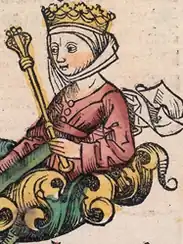
Berenice was the daughter of Costobarus and Salome I, the sister of Herod the Great.
She married her cousin Aristobulus[1] in order to reduce discord within her family caused by Herod's favoritism towards his wife Mariamne. Her marriage was an attempt to unite the two main sides of her family previously split by marriage and alleviate the tension surrounding which side would be responsible to succeeding Herod.[2] This did not solve the problems present among the heirs, and eventually Aristobulus was executed by his father in 6 BCE, and Berenice was accused of complicity in his death. By Aristobulus she was the mother of Herod Agrippa I, Herod of Chalcis, Herodias, Mariamne III and Aristobulus Minor.
Berenice maintained her elite status in Judea through her family's close ties with the Roman imperial family. [3] This tie allowed for her son Agrippa to be raised in Rome with the family of Antonia Minor, some of Rome's future leaders.
She eventually remarried to a man named, Theudion (brother of Herod I's first wife Doris, and thus uncle of Antipater), in order to strengthen her family's political ties. [4] There is little known about Berenice once Herod the Great dies, but it can be assumed that her arranged marriage did not survive the death of her uncle.
Family tree
| Costobarus | Salome I | ||||||||||||||||||||||||||||||||||||||||||
| Aristobulus d. 7 BC | Berenice (daughter of Salome) | ||||||||||||||||||||||||||||||||||||||||||
| Mariamne III | Herod V | Herodias | Herod Agrippa I | Aristobulus Minor | |||||||||||||||||||||||||||||||||||||||
| Herod Agrippa II | Berenice | Mariamne | Drusilla | ||||||||||||||||||||||||||||||||||||||||
References
- ↑ Josephus, Antiq. Jud., 16, 2
- ↑ Greenwalt, William. "Salome (c. 65 BCE–10 CE)." Women in World History: A Biographical Encyclopedia, edited by Anne Commire, vol. 13, Yorkin Publications, 2002, pp. 704–08.
- ↑ Schalit, Abraham (2007). "Berenice". In Berenbaum, Michael; Skolnik, Fred (eds.). Encyclopaedia Judaica. Vol. 3 (2nd ed.). Detroit: Macmillan Reference. pp. 410–11. ISBN 978-0-02-866097-4.
- ↑ Greenwalt, William. "Berenice (c. 35 BCE–?)." Women in World History: A Biographical Encyclopedia, edited by Anne Commire, vol. 2, Yorkin Publications, 2002, pp. 444–48